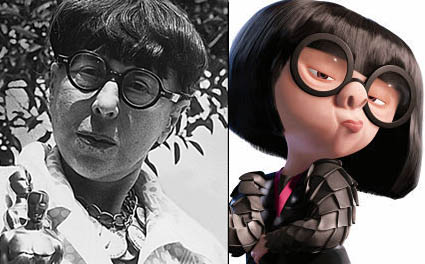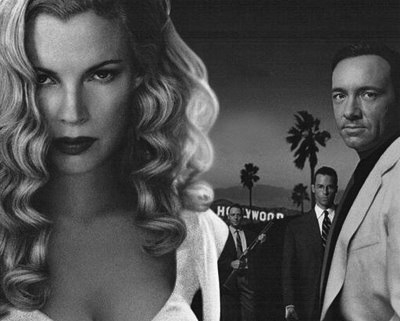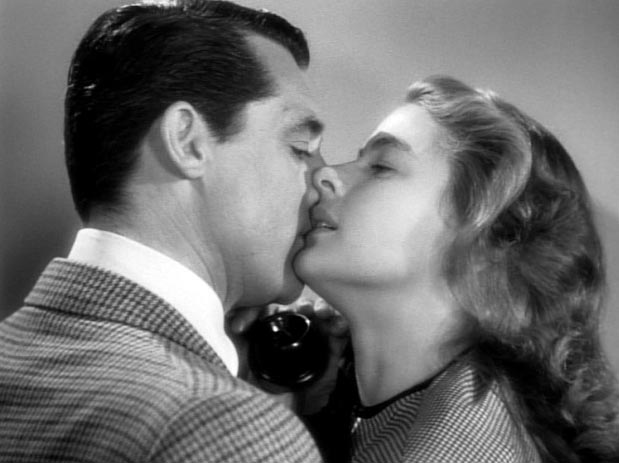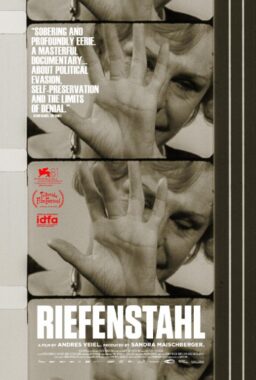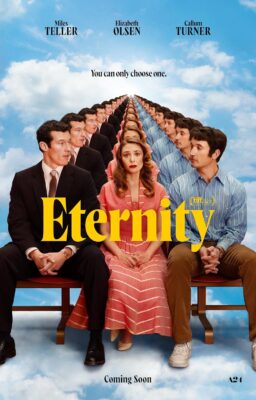Q: In your review on “The Incredibles,” you mentioned that the character Edna Mode was inspired by Q from the Bond movies. I’m pretty sure she was more based on the facial features and occupation of Edith Head, the Oscar-winning costume designer. Mohsen Ghofrani, North Canton, Ohio
A: J. Oyen of San Mateo, Calif., adds: “Edna’s uncanny resemblance to Hitchcock’s favorite costume designer and the fact that Edna is a world famous clothes designer in the movie seems to support the Edith Head connection.”
I am persuaded Edith Head is the inspiration for the character, but that her role has been enriched by Q behavior.
Q. In your Ebert & Roeper review of Michael Wilson‘s “Michael Moore Hates America,” you blurted out an erroneous opinion, expressing your doubts about the film’s claim that the Canadian crime rate is double the U.S. rate.
I checked with www.statcan.ca, listed as “the official source for Canadian social and economic statistics and products,” and with the U.S. Department of Justice Bureau of Justice Statistics. The bottom line: These sites agree with Wilson’s assertion that crime in Canada is much worse than in the USA. James Elias, Highland Ranch, Colo.
A. Astonishing. For the year 2003, per 100,000 population, Canada had 8,530 crimes, and the U.S. 4,267. For crimes of violence, 958 vs. 523. For property crimes, 4,275 vs. 3,744. Michael Wilson, director of the film, tells me: “There was originally a comedic segment in the film that attributed this to the proliferation of Tim Horton’s doughnut franchises, but I could not make it work.”
Q. A terrible thing has happened. You’ve probably heard that Theo van Gogh, a fine and most courageous filmmaker, was murdered by a Muslim extremist in Holland. Saw him the night before I left Holland some two weeks ago and we laughed about his bodyguards!
Theo dared to speak out. Dared to face the truth as he felt and perceived it. His aim was not to entertain or to reap success and glory for himself, but to transmit a message of purpose through our medium. What a tragedy that he could not escape the fate of all great humanitarians — to be sacrificed.
I’m devastated by this blow. Have worked closely with him throughout the years. It doesn’t happen — filmmakers being killed because they have something to say and dare to speak! But it did and the world has moved one step closer to the abyss. May he rest in peace. Paul Cox, Melbourne, Australia
A. The list of living directors who honor the cinema by remaining true to themselves in their work has been tragically shortened by one more name. But it still contains your name, Paul (your classic “A Woman's Tale” was my Great Movie last week)
Note: Van Gogh’s film, “Submission,” can be viewed online at ifilm.com.
Q. Regarding your Answer Man item about “What the #$*! Do We Know” being a hoax perpetrated by the Ramtha School of Enlightenment: Did you or your readers go out and sign up for Ramtha’s school? No, and neither did I. Instead I walked away absolutely astounded by the insights into my own life experience and the direction that I needed to go in order to affect my life in a positive way.
Whether the scientists in the film are “experts” or not (who defines these terms, anyway?), I found their insights and perspectives extremely helpful. The filmmakers encourage us to begin to understand the theory of quantum physics and start to ask ourselves questions that will lead us to a mindful life. Kiara Lee, Berkeley, Calif.
A. I also received a sharply worded letter from Mark Vicente, Betsy Chasse and William Arntz, the co-directors, defending the stature of their experts and the integrity of the film.
“What the #$*@!” has turned into a sleeper hit around the country, drawing repeat audiences and generating strong word of mouth. I felt a certain affection for the film, although as my original review indicated, the “movie that attempts to explain quantum physics in terms anyone can understand. It succeeds, up to a point. I understood every single term. Only the explanation eluded me.”
Among the experts on the screen, I wrote, “only one seemed to make perfect sense to me. This was a pretty, plumpish blond woman with clear blue eyes, who looked the camera straight in the eye, seemed wise and sane, and said that although the questions might be physical, the answers were likely to be metaphysical. Since we can’t by definition understand life and the world, we might as well choose a useful way of pretending to.”
This woman, I later learned, was the psychic JZ Knight, who channels a 35,000-year-old mystical sage from the lost continent of Atlantis. Still later, a letter to the Answer Man from an actual physicist, Rubin Safaya, informed me: “The individuals who are quoted are pretty far from qualified experts on the field of quantum mechanics.”
The film is what it is, a group of people trying to explain the nature of reality. The confusion comes if you think they are discussing physics, when in fact they are discussing metaphysics. There is nothing wrong with having a belief system and using it to fashion your worldview; the error comes in ascribing scientific truth to what is by definition a matter of faith.
The argument between Darwinians and Creationists is similar: Darwinians use science, Creationists use faith. “Creationist science” is laughed at by reputable scientists because it tries to use its easily refuted “science” to explain a belief that grows from and depends entirely on faith. By the same token, although the Ramtha School may indeed have valuable insights into the nature of reality, it is misleading to present them as science.
Q. Regarding your Answer Man item about the moving chair in “Citizen Kane.” I carefully reviewed the famous tracking shot that goes from a young Charles outdoors to his parents indoors. You claim a chair wiggles in this shot because it has just been put down, having been offscreen to make way for the camera’s backward movement.
The chair does indeed move, but not for that reason at all. If you watch carefully (as I’m sure you do), the chair is visible in the corner of the screen. It is not moving at all. It only wiggles when Mrs. Kane walks by it, suggesting that she has brushed it with her skirt. Why would the chair sit still and then suddenly start wiggling unless Mrs. Kane had touched it? Matt Johnson, Chicago
A. It’s not the chair, but the top hat is jiggling because the table has just been moved into position. The chair movement I’m referring to takes place toward the end of the scene, as the three adults walk back toward the window, and the camera again moves “through” the table. You can clearly see the chair being pulled away.
Q. Just a comment about your review of “Enduring Love.” You said that if all the people who grabbed hold of the ropes attached to the hot-air balloon had held on, they might have been able to keep the balloon from rising again, and that whoever was the first person to let go of the balloon was probably responsible for the death of the man who held on until he was so high that letting go caused him to fall and die.
I’m not a licensed balloon pilot, but I also have friends who are involved as crew of the Goodyear Blimp. One of the first rules of handling lighter-than-air craft is that if you are holding on to the craft in any way, the moment your feet are lifted off the ground, you let go. No ifs, ands or buts about it. I have to say that every single person I know of with lighter-than-air experience would take the view that the guy who held on and was lifted skyward was responsible for his own death. Karin Chevalier-Cozzolino, Lomita, Calif.
A. Invaluable advice. Readers: Clip and save!

